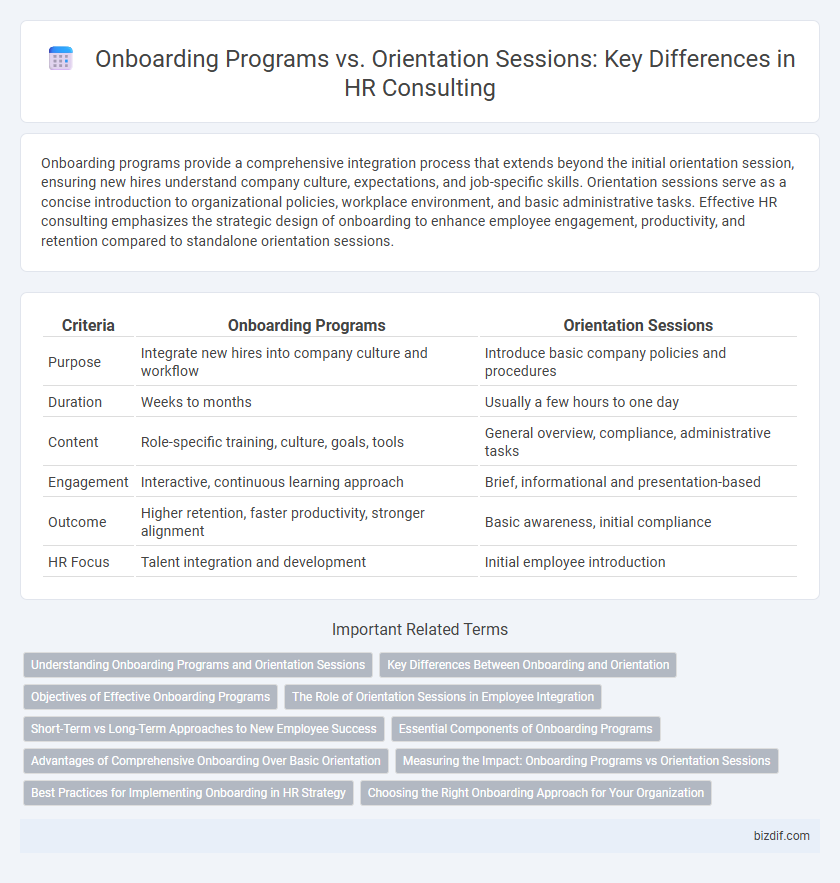Onboarding programs provide a comprehensive integration process that extends beyond the initial orientation session, ensuring new hires understand company culture, expectations, and job-specific skills. Orientation sessions serve as a concise introduction to organizational policies, workplace environment, and basic administrative tasks. Effective HR consulting emphasizes the strategic design of onboarding to enhance employee engagement, productivity, and retention compared to standalone orientation sessions.
Table of Comparison
| Criteria | Onboarding Programs | Orientation Sessions |
|---|---|---|
| Purpose | Integrate new hires into company culture and workflow | Introduce basic company policies and procedures |
| Duration | Weeks to months | Usually a few hours to one day |
| Content | Role-specific training, culture, goals, tools | General overview, compliance, administrative tasks |
| Engagement | Interactive, continuous learning approach | Brief, informational and presentation-based |
| Outcome | Higher retention, faster productivity, stronger alignment | Basic awareness, initial compliance |
| HR Focus | Talent integration and development | Initial employee introduction |
Understanding Onboarding Programs and Orientation Sessions
Onboarding programs encompass comprehensive processes designed to integrate new employees into the company culture, role expectations, and team dynamics over weeks or months, enhancing retention and productivity. Orientation sessions are brief, initial activities aimed at providing essential administrative information and facility tours, serving as the introductory phase within the broader onboarding strategy. Effective HR consulting differentiates these elements to tailor integration strategies that promote employee engagement and seamless adaptation.
Key Differences Between Onboarding and Orientation
Onboarding programs encompass a comprehensive integration process designed to align new employees with company culture, roles, and long-term goals, extending over weeks or months. Orientation sessions are brief, typically one-day events concentrating on administrative tasks like policy reviews, benefits enrollment, and workplace logistics. The key differences lie in onboarding's strategic scope, aiming for sustained engagement and productivity, versus orientation's focus on immediate, essential information delivery.
Objectives of Effective Onboarding Programs
Effective onboarding programs accelerate employee productivity by providing comprehensive training, clear role expectations, and integration into company culture. These programs aim to enhance retention rates through personalized support, continuous feedback, and engagement initiatives. Unlike brief orientation sessions, onboarding fosters long-term commitment by aligning new hires with organizational goals and values.
The Role of Orientation Sessions in Employee Integration
Orientation sessions play a crucial role in accelerating employee integration by providing new hires with essential information about company culture, policies, and job expectations during their initial days. These sessions foster early engagement, reduce anxiety, and build a foundation for productive relationships between employees and their teams. Effective orientation enhances retention rates and supports smoother transitions into the organizational environment.
Short-Term vs Long-Term Approaches to New Employee Success
Onboarding programs emphasize long-term employee success by delivering continuous training, cultural integration, and performance support over weeks or months. Orientation sessions provide short-term benefits through initial introductions to company policies, team members, and workplace logistics, typically lasting one to two days. Investing in comprehensive onboarding increases retention rates, accelerates productivity, and boosts employee engagement beyond the immediate orientation phase.
Essential Components of Onboarding Programs
Onboarding programs encompass comprehensive elements such as role-specific training, company culture immersion, and continuous performance feedback to ensure employee integration and engagement. These essential components go beyond one-time orientation sessions by providing structured learning paths, goal setting, and mentorship opportunities. Effective onboarding reduces turnover rates and accelerates productivity by fostering long-term employee commitment.
Advantages of Comprehensive Onboarding Over Basic Orientation
Comprehensive onboarding programs significantly improve employee retention rates by fostering deeper engagement and faster productivity through structured training, mentorship, and goal-setting activities. Unlike basic orientation sessions, which primarily cover company policies and introduce coworkers, onboarding integrates cultural assimilation and role-specific skills development, enhancing long-term job satisfaction. Studies show that organizations with robust onboarding see a 50% greater new hire performance and a 69% higher retention rate within three years.
Measuring the Impact: Onboarding Programs vs Orientation Sessions
Measuring the impact of onboarding programs involves tracking employee retention rates, productivity metrics, and engagement scores over several months, providing a comprehensive view of long-term integration success. Orientation sessions primarily gauge immediate knowledge retention and initial satisfaction through surveys and quizzes conducted within the first week. Companies leveraging detailed analytics for onboarding programs often see higher ROI in talent development compared to reliance on brief orientation sessions alone.
Best Practices for Implementing Onboarding in HR Strategy
Effective onboarding programs extend beyond initial orientation sessions by incorporating structured training, mentorship, and regular check-ins to ensure employee engagement and retention. Best practices in HR strategy emphasize personalized onboarding plans tailored to role-specific needs, fostering early productivity and cultural integration. Leveraging technology and feedback mechanisms enhances the onboarding experience, promoting continuous improvement and alignment with organizational goals.
Choosing the Right Onboarding Approach for Your Organization
Effective onboarding programs extend beyond basic orientation sessions by integrating comprehensive training, cultural immersion, and ongoing support to enhance employee retention and productivity. Organizations aiming for long-term engagement should prioritize customized onboarding frameworks tailored to specific roles and company values, rather than one-time orientation events. Data shows that structured onboarding improves new hire retention by 82% and productivity by over 70%, making it crucial to select approaches that align with organizational goals and workforce needs.
Onboarding Programs vs Orientation Sessions Infographic

 bizdif.com
bizdif.com